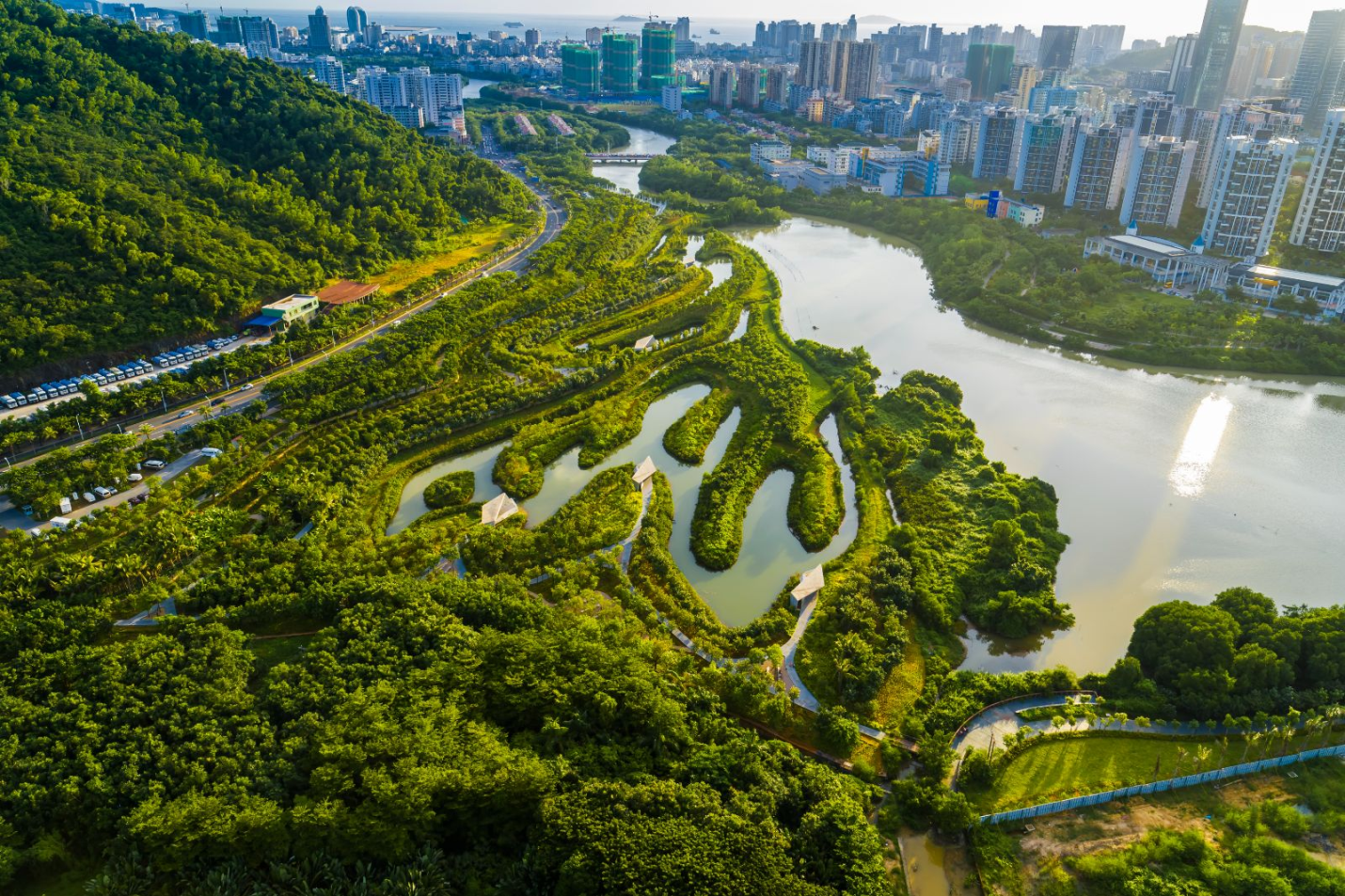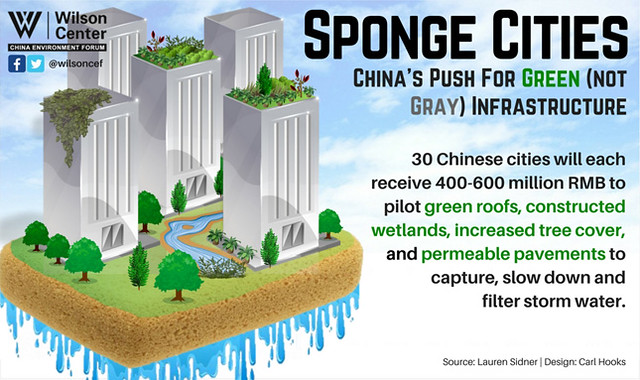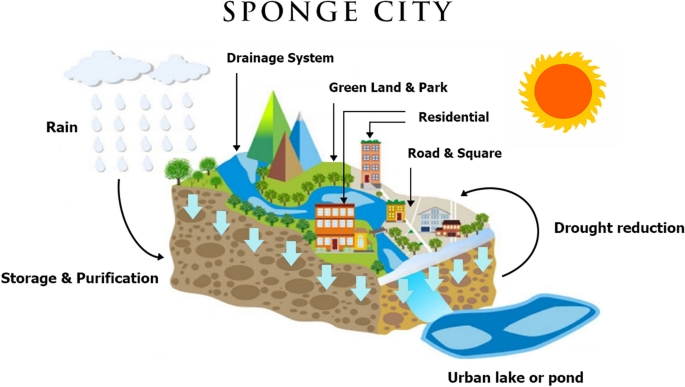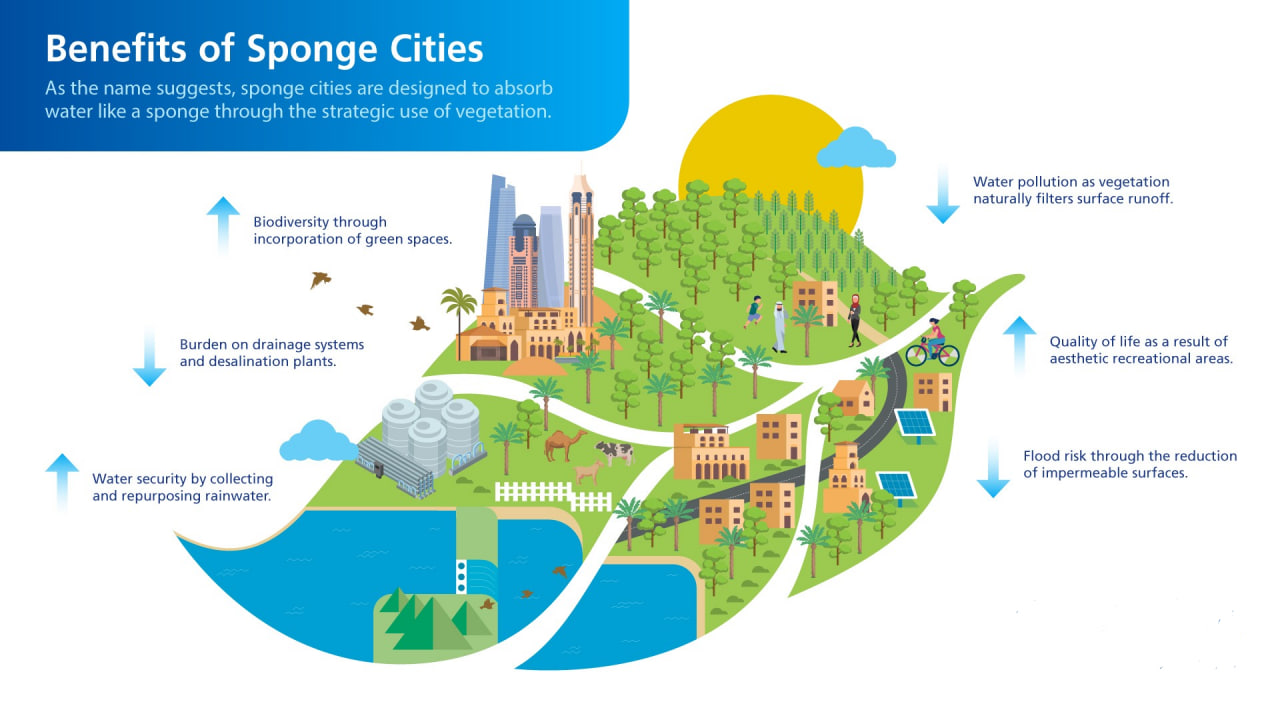
Copyright infringement not intended
Picture Courtesy: https://www.ajlajournal.org/articles/the-sponge-city-planning-design-and-political-design
Context: Climate change has intensified urban floods, leading to the introduction of "sponge city" concepts, which use unique drainage techniques to reduce flood risks.
Background
- Traditional stormwater management systems in cities involve centralized sewage systems that discharge stormwater into nearby water bodies, which often leads to pollution and increased flood risks downstream.
- The evolution of green infrastructure began with efforts to comply with decentralized water regulations. Green infrastructure, such as rain gardens, green roofs, and permeable pavements, was implemented to filter pollutants from stormwater before it enters waterways.
- The "sponge city" concept involves designing urban landscapes to soak up and filter stormwater, reducing runoff and mitigating flood risks.
About Sponge City
- Sponge cities are a new approach to urban planning that emphasizes flood management and water conservation through the strategic use of green infrastructure. This concept is inspired by nature's ability to absorb rainwater, mimicking a sponge.
- The term "sponge city" originated in China, it refers to "a new urban planning model in China that emphasizes flood management via strengthening green infrastructures instead of purely relying on drainage systems."

Objectives of Sponge Cities
- Reduce urban flooding: By increasing infiltration and storage of rainwater, sponge cities aim to lessen the burden on traditional drainage systems, thereby reducing the risk of flooding during heavy rainfall events.
- Reduce water scarcity: Captured rainwater can be stored and reused for non-potable purposes like irrigation or flushing toilets, reducing reliance on strained freshwater resources.
- Mitigate urban heat island effect: Green infrastructure, like trees and parks, can help to cool urban environments by providing shade and evapotranspiration (the release of water vapor from plants).
- Enhance ecological biodiversity: By creating green spaces and restoring natural waterways, sponge cities can provide habitat for various plant and animal species, promoting a more diverse urban ecosystem.
- Promote sustainable water management: Sponge cities encourage a shift towards a more natural and sustainable approach to managing water resources within urban areas.

Key elements of Sponge Cities
Urban parks
- Urban parks serve as multifunctional spaces within cities, providing recreational areas for residents while also serving as important components of stormwater management. They can absorb and store rainfall, reducing runoff and the risk of flooding.
Gardens
- Gardens, including community gardens and private green spaces, contribute to the absorption of rainfall and promote biodiversity within urban environments. They enhance permeability of the soil, allowing water to infiltrate and reduce surface runoff.
GreenSpaces
- Similar to urban parks, green spaces such as lawns and landscaped areas help mitigate flooding by absorbing and storing rainfall. They also contribute to the aesthetic and environmental quality of urban areas.
Wetlands
- Wetlands play a crucial role in stormwater management by naturally filtering pollutants and slowing down the flow of water. They provide habitat for diverse plant and animal species and help maintain ecological balance within urban ecosystems.
Nature Strips
- Nature strips, also known as bioswales or vegetated swales, are vegetated areas typically located between sidewalks and roadways. They help capture and filter stormwater runoff, reducing pollution and minimizing the risk of flooding.
Permeable pavements
- Permeable pavements are surfaces that allow water to infiltrate through them into the ground below. This reduces surface runoff and helps replenish groundwater supplies. Permeable pavements can include materials such as permeable concrete, porous asphalt, or interlocking pavers.
Benefits of Sponge Cities
Reduced flood risks
- Sponge cities implement innovative stormwater management strategies that reduce surface runoff and enhance water absorption into the ground.
- By capturing and storing rainwater, sponge cities mitigate flooding risks during heavy rainfall events, protecting communities and infrastructure from water-related disasters.
Improved water quality
- The use of green infrastructure in sponge cities helps filter and treat stormwater runoff before it enters natural water bodies.
- Vegetated elements like rain gardens, wetlands, and permeable pavements remove pollutants such as sediment, nutrients, heavy metals, and pathogens, thereby improving the quality of water that eventually reaches rivers, lakes, and oceans.
Enhanced urban aesthetics
- Incorporating green spaces, urban parks, green roofs, and other natural elements into urban environments enhances the aesthetic appeal of cities.
- Green infrastructure not only provides functional benefits but also contributes to a more attractive and livable urban landscape, promoting well-being and community pride.
Increased resilience to climate change
- Sponge cities are designed to adapt to and mitigate the impacts of climate change, including increased frequency and intensity of rainfall events.
- By incorporating nature-based solutions, such as wetlands, green roofs, and permeable pavements, cities become more resilient to extreme weather events, reducing vulnerabilities and ensuring sustainable urban development.
Sustainable use of water resources
- The adoption of sponge city concepts encourages sustainable water management practices.
- By capturing and reusing rainwater, promoting groundwater recharge, and minimizing reliance on centralized drainage systems, sponge cities optimize the use of water resources. This contributes to water conservation and supports long-term sustainability of urban water systems.
|
Implementing sponge city strategies not only addresses immediate challenges related to urban flooding and water pollution but also fosters holistic urban development that prioritizes environmental, social, and economic sustainability. These benefits highlight the importance of integrating green infrastructure and nature-based solutions into urban planning and design to create resilient, livable cities for present and future generations.
|

Global Perspectives on Sponge Cities and Green Infrastructure
Inspired by ancient adaptation practices
- The concept of sponge cities and green infrastructure draws inspiration from ancient adaptation practices used by civilizations around the world.
- Historically, communities have employed nature-based solutions such as wetlands, terraced landscapes, and water harvesting techniques to manage water resources sustainably and mitigate flooding.
- Modern sponge city initiatives build upon the traditional practices, integrating innovative technologies with indigenous knowledge to address contemporary urban challenges.
Part of a worldwide movement towards green infrastructure
- Sponge cities and green infrastructure are integral components of a global movement towards sustainable urban development.
- Cities across the world are embracing nature-based solutions to enhance resilience, mitigate climate risks, and improve environmental quality. This movement reflects a growing recognition of the importance of integrating natural systems into urban planning and infrastructure design to create healthier, more livable cities.
Similar concepts adopted in Europe
- Many cities in Europe have promoted green infrastructure and sponge city concepts to address water management challenges. For example, cities like Copenhagen in Denmark have implemented innovative stormwater management strategies, including green roofs, permeable pavements, and constructed wetlands, to reduce flood risks and improve water quality.
Similar concepts adopted in the United States
- Numerous cities in the United States, such as Philadelphia, New York City, Seattle, and Portland, have implemented green infrastructure projects to manage stormwater runoff and promote environmental sustainability. These initiatives include rain gardens, bioswales, green roofs, and permeable pavements, demonstrating a shift towards nature-based solutions in urban planning.
Similar concepts adopted in Australia
- Australian cities like Melbourne and Sydney have embraced green infrastructure to enhance water management and urban resilience. Green roofs, rain gardens, and water-sensitive urban design (WSUD) principles are widely used to capture and reuse stormwater, reduce flooding, and improve water quality in urban areas.
|
Overall, sponge city concepts and green infrastructure practices have gained momentum globally as cities seek innovative solutions to address water-related challenges and foster sustainable urban development. By integrating nature-based approaches into urban planning and infrastructure, cities can create resilient, adaptive, and environmentally friendly environments for residents and ecosystems alike.
|
Challenges
Initial investment costs
- One of the primary challenges of implementing green infrastructure and sponge city initiatives is the upfront investment required.
- Securing funding for these projects can be challenging, especially for cash-strapped municipalities. However, it's important to consider the long-term benefits and cost savings associated with reduced flood damage, improved water quality, and enhanced urban livability.
Land use and space requirements
- Green infrastructure projects require adequate land and space for implementation. This can be a constraint in densely populated urban areas where land is limited and valuable.
- Balancing the need for green spaces with other urban development priorities requires thoughtful planning and coordination among stakeholders.
Maintenance and monitoring
- Proper maintenance and ongoing monitoring are critical for the effectiveness and longevity of green infrastructure.
- Vegetated elements such as rain gardens, green roofs, and bioswales require regular upkeep, including wedding, pruning, and sediment removal. Municipalities must allocate resources for maintenance to ensure that green infrastructure functions optimally and delivers expected benefits over time.
Integration with existing infrastructure
- Integrating green infrastructure with existing urban infrastructure (e.g., stormwater systems, transportation networks) presents technical challenges.
- Coordination among different departments and agencies responsible for infrastructure planning and management is essential to ensure seamless integration and avoid conflicts with other utilities or services.
Community acceptance and participation
- Community engagement and support are key considerations in the successful implementation of sponge city and green infrastructure projects.
- Building awareness, educating residents about the benefits of green infrastructure, and involving stakeholders in the planning process can foster community buy-in and participation.
- Addressing concerns related to aesthetics, safety, and perceived inconveniences associated with green infrastructure installations is crucial for garnering public support.
|
Addressing the challenges requires a holistic approach that considers technical, financial, social, and environmental aspects of urban development. Municipalities and stakeholders can leverage partnerships, innovative financing mechanisms, and capacity-building initiatives to overcome barriers and realize the full potential of green infrastructure in creating sustainable and resilient cities.
|
Way Forward
Comprehensive Planning and Design
- Develop holistic plans that include sponge city principles into existing urban planning frameworks, considering green and gray infrastructure in a coordinated manner.
- Implement pilot projects in specific districts to test different approaches, gather data, and refine strategies before large-scale implementation.
- Explore cost-effective ways to retrofit existing infrastructure, such as incorporating green roofs on buildings or installing rain gardens in parking lots.
Secure Funding and Investment
- Strengthening collaboration between public and private sectors to leverage funding and expertise for sponge city projects.
- Explore innovative financing mechanisms, such as green bonds or stormwater utilities, to attract investment for sponge city development.
- Conduct thorough cost-benefit analyses to demonstrate the long-term economic and environmental benefits of sponge cities.
Advance Technologies and Practices
- Invest in research and development of new green infrastructure technologies and materials to improve efficiency and cost-effectiveness.
- Develop a comprehensive data collection and monitoring systems to track the performance of sponge city initiatives and inform future improvements.
- Establish platforms for knowledge sharing and collaboration among cities implementing sponge city concepts around the world.
Public Education and Engagement
- Raise public awareness about the benefits of sponge cities and encourage community participation in planning and implementation processes.
- Develop educational programs to educate citizens on water conservation practices and responsible stormwater management.
- Offer incentives, such as tax breaks or rebates, to encourage property owners to adopt green infrastructure solutions on their properties.
Conclusion
- The concept of sponge cities represents a holistic and innovative approach to urban development that leverages green infrastructure to effectively manage water, mitigate flooding, improve ecological health, and enhance resilience to climate change impacts.
Must Read Articles:
SPONGE CITIES
Source:
Down To Earth
Wikipedia
Archdaily
Business Standard
|
PRACTICE QUESTION
Q. Sponge city design involves integrating green and grey infrastructure. How to effectively balance the need for flood control and water retention with the demands of urban development and existing infrastructure in a way that is both economically feasible and aesthetically pleasing?
|



















